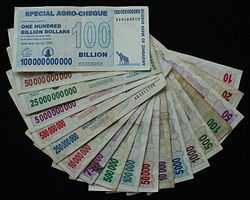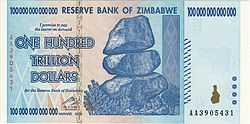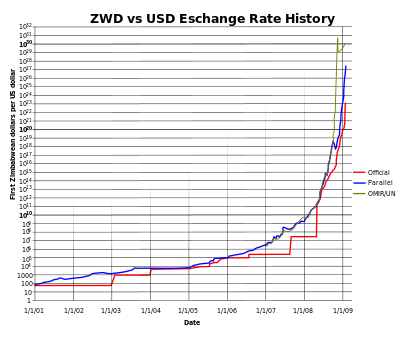Hyperinflation in Zimbabwe

Hyperinflation in Zimbabwe was a period of currency instability that began in the late 1990s, shortly after the confiscation of private farms from white landowners, towards the end of Zimbabwean involvement in the Second Congo War. During the height of inflation from 2008 to 2009, it was difficult to measure Zimbabwe's hyperinflation because the government of Zimbabwe stopped filing official inflation statistics.[1] However, Zimbabwe's peak month of inflation is estimated at 79.6 billion percent in mid-November 2008.[1]
In 2009, Zimbabwe abandoned its currency. As of 2015, Zimbabwe still has no national currency with currencies from other countries being used.[2]
Historical context
On 18 April 1980, the Republic of Zimbabwe was born from the former British colony of Southern Rhodesia. The Rhodesian Dollar was replaced by the Zimbabwe dollar at par value. When Zimbabwe gained independence, the Zimbabwean dollar was more valuable than the US dollar.[3] In its early years, Zimbabwe experienced strong growth and development. Wheat production for non-drought years was proportionally higher than in the past. The tobacco industry was thriving as well. Economic indicators for the country were strong.
From 1991–1996, the Zimbabwean Zanu-PF government of president Robert Mugabe embarked on an Economic Structural Adjustment Programme (ESAP), designed by the IMF and the World Bank, that had serious negative effects on Zimbabwe's economy. In the late 1990s, the government instituted land reforms intended to redistribute land from white landowners to black farmers to correct the 'injustices of colonialism'. However, many of these farmers had no experience or training in farming. From 1999 to 2009, the country experienced a sharp drop in food production and in all other sectors. The banking sector also collapsed, with farmers unable to obtain loans for capital development. Food output capacity fell 45%, manufacturing output 29% in 2005, 26% in 2006 and 28% in 2007, and unemployment rose to 80%.[4] Life expectancy dropped.[5]
The Reserve Bank of Zimbabwe blamed the hyperinflation on economic sanctions imposed by the United States of America, the IMF and the European Union.[6][7] These sanctions affect the government of Zimbabwe,[8] and asset freezes and visa denials targeted at 200 specific Zimbabweans closely tied to the Mugabe regime.[9] There are also restrictions placed on trade with Zimbabwe, by both individual businesses and the US Treasury Department's Office of Foreign Asset Control.[10]
Causes

A monetarist view[11] is that a general increase in the prices of things is less a commentary on the worth of those things than on the worth of the money. This has objective and subjective components:
- Objectively, that the money has no firm basis to give it a value.
- Subjectively, that the people holding the money lack confidence in its ability to retain its value.
Crucial to both components is discipline over the creation of additional money. However, the Mugabe government was printing money to finance involvement in the Democratic Republic of the Congo and, in 2000, in the Second Congo War, including higher salaries for army and government officials. Zimbabwe was under-reporting its war spending to the International Monetary Fund by perhaps $22 million a month.[12]
Another motive for excessive money creation has been self-dealing. Transparency International ranks Zimbabwe's government 157th of 177[13] in terms of institutionalised corruption.[14] The resulting lack of confidence in government undermines confidence in the future and faith in the currency.
Economic mis-steps by government can create shortages and occupy people with workarounds rather than productivity. Though this harms the economy, it does not necessarily undermine the value of the currency, but may harm confidence in the future. Widespread poverty and violence, including government violence to stifle political opposition, also undermines confidence in the future.[15] Land reform lowered agricultural output, especially in tobacco, which accounted for one-third of Zimbabwe's foreign-exchange earnings. Manufacturing and mining also declined. An objective reason was, again, that farms were put in the hands of inexperienced people; and subjectively, that the move undermined the security of property.
Government instability and civic unrest were evident in other areas.[16] Zimbabwean troops, trained by North Korean soldiers, conducted a massacre in the 1980s in the southern provinces of Matabeleland and Midlands, though Mugabe's government cites guerrilla attacks on civilian and state targets. Conflicts between the Ndebele ethnic minority and Mugabe's majority Shona people have led to many clashes,[17] and there is also unrest between blacks and whites, in which the land reform was a factor. An aspect of this reform that seeks to bar whites from business ownership induced many to leave the country.[18]
Self-perpetuation
Lack of confidence in government to practice fiscal restraint feeds on itself. In Zimbabwe, neither the issuance of banknotes of higher denominations nor proclamation of new currency regimes led holders of the currency to expect that the new money would be more stable than the old. Remedies announced by the government never included a believable basis for monetary stability.[19][20] Thus, one reason the currency continued to lose value, causing hyperinflation, is that so many people expected it to.[21]
Inflation rate
| Zimbabwean inflation rates since independence (official up to Jul. 2008, estimates thereafter) | ||||||||||||||||
| Date | Rate | Date | Rate | Date | Rate | Date | Rate | Date | Rate | Date | Rate | |||||
|---|---|---|---|---|---|---|---|---|---|---|---|---|---|---|---|---|
| 1980 | 7% | 1986 | 15% | 1992 | 40% | 1998 | 48% | 2004 | 132.75% | 2008 Sep. | 3,840,000,000,000,000,000% | |||||
| 1981 | 14% | 1987 | 10% | 1993 | 20% | 1999 | 56.9% | 2005 | 585.84% | 2008 Mid-Nov. | 89,700,000,000,000,000,000,000% | |||||
| 1982 | 15% | 1988 | 7.3% | 1994 | 25% | 2000 | 55.22% | 2006 | 1,281.11% | |||||||
| 1983 | 19% | 1989 | 14% | 1995 | 28% | 2001 | 112.1% | 2007 | 66,212.3% | |||||||
| 1984 | 10% | 1990 | 17% | 1996 | 16% | 2002 | 198.93% | 2008 Jul. | 231,150,888.87% | |||||||
| 1985 | 10% | 1991 | 48% | 1997 | 20% | 2003 | 598.75% | 2008 Aug. | 471,000,000,000% | |||||||
Over the course of the five-year span of hyperinflation, the inflation rate fluctuated greatly. At one point, the US Ambassador to Zimbabwe predicted that it would reach 1.5 million percent. In June 2008 the annual rate of price growth was 11.2 million percent. The worst of the inflation occurred in 2008, leading to the abandonment of the currency. The peak month of hyperinflation occurred in mid-November 2008 with a rate estimated at 79,600,000,000% per month.[22] US$1 was equivalent to $Z2,621,984,228[23] in October 2008.[24][25][26]
Adaptations
Use of foreign currencies
In 2007, the government declared inflation illegal. Anyone who raised the prices for goods and services was subject to arrest. This amounted to a price freeze, which is usually ineffective in halting inflation.[27] Officials arrested numerous corporate executives for changing their prices.[28]
In December 2008, the Central Bank of Zimbabwe licensed around 1,000 shops to deal in foreign currency.[29][30] Citizens had increasingly been using foreign currency in daily exchanges, as local shops stated fewer prices in Zimbabwe dollars because they needed foreign currency to import foreign goods. Many businesses and street vendors continued to do so without getting the license.[31]
In January 2009, acting Finance Minister Patrick Chinamasa lifted the restriction to use only Zimbabwean dollars. This too acknowledged what many were already doing. Citizens were allowed to use the US dollar, the euro, and the South African rand. However, teachers and civil servants were still being paid in Zimbabwean dollars. Even though their salaries were in the trillions per month, this amounted to around US$1, or half the daily bus fare.[32] The government also used a restriction on bank withdrawals to try to limit the amount of money that was in circulation. It limited cash withdrawals to $Z500,000, which was around US$0.25.[33]
The black market

Living with hyperinflation was a challenge for Zimbabweans. Prices in shops and restaurants were still quoted in Zimbabwean dollars, but were adjusted several times a day. Any Zimbabwean dollars acquired needed to be exchanged for foreign currency on the parallel market immediately,[34] or the holder would suffer a significant loss of value. For example, a mini-bus driver charged riders in Zimbabwean dollars, but different rates throughout the day: The evening commute was highest-priced. He sometimes exchanged money three times a day, not in banks but in back office rooms and parking lots.
Such business venues constituted a black market, an arena explicitly outside the law. Transactors could evade the price freezes and the mandate to use Zimbabwean dollars.
The black market served the demand for daily goods such as soap and bread, as grocery stores operating within the law no longer sold items whose prices were strictly controlled, or charged customers more if they were paying in Zimbabwean dollars.[35] At one point, a loaf of bread was Z$550 million in the regular market, when bread was even available; apart from a trip to another country, the black market was the only option for almost all goods, and bread might cost Z$10 billion.[36]
Redenomination
At independence in 1980, the Zimbabwe dollar became the common currency. Originally, the paper notes were Z$20, 10, 5, and 2, and the coins were Z$1, and 50, 20, 10, 5, and 1 cents. As larger bills were needed to pay for menial amounts, the Central Bank of Zimbabwe planned to print and circulate denominations of up to Z$10, 20, 50, and 100 trillion.[37] Announcements of new denominations were increasingly frequent; the Z$200,000,000 bill was announced just days after the printing of the Z$100,000,000 bill.
The government did not attempt to fight inflation with fiscal and monetary policy. In 2006, before hyperinflation reached its peak, the bank announced it would print larger bills to buy foreign currencies. The Reserve Bank printed a Z$21 trillion bill to pay off debts owed to the International Monetary Fund.
On three occasions, the Central Bank of Zimbabwe redenominated the currency. First, in August 2006, the Central Bank recalled notes in exchange for new notes with three zeros slashed from the currency.[38] In July 2008, the governor of the Reserve Bank of Zimbabwe, Gideon Gono, announced a new Zimbabwean dollar, this time with 10 zeros removed. The Z$10 billion would be redenominated to be Z$1.[39] This move was not just to slow inflation but also to make computations more manageable.[40]
A third redenomination, producing the "fourth Zimbabwe dollar," occurred in February 2009, and dropped 12 more zeros from the currency. It was thus worth 10 trillion trillion original dollars, as the three redenominations together reduced the value of an original dollar by 103 × 1010 × 1012 = 1025.
Solutions
The government could declare some foreign currency to be the nation's official currency. To facilitate commerce, it was less important which currency was adopted than that the government standardise on a single currency. The US dollar, the euro, and the South African rand were candidates; the US dollar had the most credibility and was the most widely traded within Zimbabwe.[41] Zimbabwe could have joined the nearby nations of Lesotho, Namibia, South Africa, and Swaziland, which constitute the Common Monetary Area, or "Rand Zone"[3] by formally deciding to use the rand to promote trade and stability.[42]
In 2009, the government abandoned printing Zimbabwean dollars at all.[41] This implicitly solved the chronic problem of lack of confidence in the Zimbabwean dollar, and compelled people to use the foreign currency of their choice. From then through 2014, Zimbabwe still used a combination of foreign currencies, mostly US dollars.
In 2014, the Reserve Bank of Zimbabwe unveiled "centavo" coins in denominations of US$0.01 through US$0.50. The Bank said that 80% of Zimbabweans use the U.S. dollar, and said the local lack of coins induces retailers to round prices up to the next higher dollar. The coins extend the use of the dollar as a de facto currency, and indeed the Bank repeated assurances that it does not intend to bring back a national currency.[43]
References
- ↑ 1.0 1.1 Hanke, Steve H; Alex KF Kwok (Spring–Summer 2009). "On the Measurement of Zimbabwe's Hyperinflation" (PDF). The Cato Journal.
- ↑ "Zimbabwe Abandons Its Currency". BBC. 29 January 2009.
- ↑ 3.0 3.1 "Zimbabwe A worthless Currency". The Economist. 17 July 2008. Retrieved 17 April 2010.
- ↑ Marshall Auerbeck. "Will the US turn into a modern day Weimar Germany?" (PDF). Netrootmass.net. Retrieved 2012-11-19.
- ↑ Coltart, David (2008). "A Decade of Suffering in Zimbabwe". CATO.
- ↑ http://www.rbz.co.zw/pdfs/2007mid/imp1_7.pdf
- ↑ Illegal Sanctions to Blame for Economic Challenges – Mutasa The Herald (Harare)
- ↑ S. 494 (107th): Zimbabwe Democracy and Economic Recovery Act of 2001 SEC. 4. SUPPORT FOR DEMOCRATIC TRANSITION AND ECONOMIC RECOVERY. See Section 4C.
- ↑ EU renews Zimbabwe sanctions, By Sebastien Berger, The Telegraph, 16 February 2010.
- ↑ Office of Foreign Asset Control, US Treasury Department PROHIBITED TRANSACTIONS
- ↑ See, for instance, Friedman, Milton. Inflation: Causes and Consequences. New York: Asia Publishing House: "Inflation is always and everywhere a monetary phenomenon."
- ↑ "Mugabe's Costly Congo Venture". BBC Online. 25 July 2000. Retrieved 19 April 2011.
- ↑ http://www.transparency.org/country#ZWE
- ↑ "Corruption Index". Transparency International. Retrieved 19 April 2011.
- ↑ "The Economies of Violence". The Economist. 14 April 2011. Retrieved 17 April 2011.
- ↑ Capie, Forest (1986). "Conditions in which very Rapid Hyperinflation has occurred". Carnegie-Rochester Conference Series on Public Policy 24: 115–168. doi:10.1016/0167-2231(86)90007-2.
- ↑ Latham, Brian (3 May 2010). "North Korea Soccer Team May Face Zimbabwe Massacre Protests". Business Week Online. Retrieved 17 April 2011.
- ↑ "Bitterness and unease in Bankrupt Zimbabwe". BBC Online. 6 March 2010. Retrieved 19 April 2011.
- ↑ Coltart, David (24 March 2008). "A Decade of Suffering in Zimbabwe". The Cato Institute.
- ↑ Krugman, Paul F (2005). International Economics; Theory and Policy. Pearson. pp. 363–366.
- ↑ Christiano, Lawrence (February 1987). "Cagan's Model of Hyperinflation Under Rational Expectations". International Economic Review 28 (1).
- ↑ "Hanke S., & Kwok, A. (2009) "On the Measurement of Zimbabwe's Hyperinflation", Cato Journal, 29 (2)" (PDF). Retrieved 30 July 2012.
- ↑ "Forex Rates". Retrieved 18 April 2011.
- ↑ Fanuel Jongwe (9 October 2008). "Zimbabwe inflation soars to 231 million percent". Yahoo! News. Retrieved 2009-01-29.
- ↑ Martin Kadzere (9 October 2008). "Zimbabwe: Inflation Soars to 231 Million Percent". allAfrica.com / The Herald (Harare). Retrieved 2008-10-10.
- ↑ Zimbabwe inflation hits new high BBC News, 9 October 2008
- ↑ Wines, Michael (7 February 2007). "As Inflation Soars, Zimbabwe Economy Plunges". The New York Times. Retrieved 4 May 2010.
- ↑ "Zimbabwe jail over bread prices". BBC News. 1 December 2006. Retrieved 4 May 2010.
- ↑ Zimbabwe economy virtually foreign exchange-based: media Yahoo News, 1 January 2009
- ↑ Zimbabwe: Econet Subscribers Caught Unawares allAfrica.com, 3 January 2009
- ↑ Harare diary: 'Hope has died', BBC News, 21 January 2009
- ↑ "Zimbabwe Abandons Its Currency". BBC Online. 29 January 2009.
- ↑ Hyperinflation forces Zimbabwe to print $200 million notes. (6 December 2008). CNN. Retrieved 6 December 2008.
- ↑ Van Gelder, Elles. "Zimbabwe; Black Market Thriving". Retrieved 15 April 2011.
- ↑ "Zimbabwe; A worthless currency". The Economist. 17 July 2008. Retrieved 15 April 2011.
- ↑ McLaughlin, Elliot (25 June 2008). "Harare Woman; If you talk to much... they hunt you down.". CNN Online. Retrieved 18 April 2011.
- ↑ "Zimbabwe Rolls Out Z$100tr Note". BBC Online. 16 January 2009. Retrieved 13 April 2011.
- ↑ "Zimbabwe's 'cosmetic' cash reforms rapped". 6 August 2006. Archived from the original on 27 August 2006.
- ↑ "Zimbabwe introduces new currency". BBC. 30 July 2008. Retrieved 2008-07-30.
- ↑ "Zimbabwe Abandons Its Currency". BBC Online. 29 January 2009. Retrieved 15 April 2011.
- ↑ 41.0 41.1 Hanke, Steve (June 2008). "Zimbabwe; From Hyperinflation to Growth". The Cato Institute 6: 1–36. Retrieved 7 April 2011.
- ↑ Grandes, Martin (December 2003). "Macroeconomic Convergence: In Southern Africa: The Rand Zone Experience" (PDF). OECD Development Center. Working Paper 231. Retrieved 15 April 2011.
- ↑ Chipo Musoko (2014-12-05). "RBZ issues ‘centavo’ coins, says bringing back Zimbabwe dollar suicidal". The Source. Retrieved 2014-12-08.